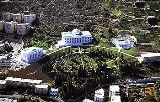
Bahá'í World Centre buildings
Encyclopedia
The Bahá'í World Centre buildings are buildings that are part of the Bahá'í World Centre
in Israel
. The Bahá'í World Centre buildings include both the Bahá'í holy places used for pilgrimage
and the international administrative bodies of the Bahá'í Faith
; they comprise more than 20 different administrative offices, pilgrim buildings, libraries, archives, historical residences, and shrines. These structures are all set amidst more than 30 different gardens or individual terraces.
The buildings themselves are located in Haifa
, Acre
, and Bahjí, Israel. The location of the Bahá'í World Centre buildings has its roots to Bahá'u'lláh
's imprisonment in Acre, which is near Haifa, by the Ottoman Empire
during the Ottoman Empire's rule over Palestine
, now Israel
.
Many Bahá'í holy places in Haifa
and around Acre
, including the terraces and the Shrine of the Báb
on the north slope on Mount Carmel
, and the Shrine of Bahá'u'lláh, the Mansion of Bahji, and the Mansion at Mazra'ih were inscribed on the World Heritage List in July 2008. The Bahá'í shrines "are the first sites connected with a relatively new religious tradition to be recognized by the World Heritage List." The UNESCO World Heritage Committee considers the sites to be "of outstanding universal value [and]...inscribed for the testimony they provide to the Bahá’i’s strong tradition of pilgrimage and for their profound meaning for the faith."
is the third-largest city in Israel
, and it is a seaport, located below and on Mount Carmel, and lies on the Mediterranean coast. In 1891 Bahá'u'lláh
himself designated Mount Carmel as the location for the Shrine of the Báb
. Later, Bahá'u'lláh in the Tablet of Carmel wrote that Mount Carmel would be the physical location of the Bahá'í World Centre
.
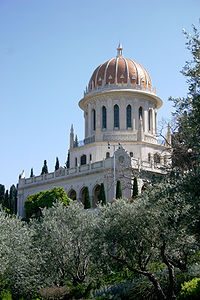 The Shrine of the Báb is the location where the Báb
The Shrine of the Báb is the location where the Báb
's remains have been laid to rest. The location was designated by Bahá'u'lláh
himself in 1891 while he was camped, with `Abdu'l-Bahá
, across from Mount Carmel
. The location is right above the German Colony
, which was established in the 1860s by the German Templer Society
, who were working for the Kingdom of God
on earth. The shrine was built by `Abdu'l-Bahá in 1909. Many years later, the superstructure was completed by Shoghi Effendi
, and finally dedicated in 1953.
The architect
was William Sutherland Maxwell
, a Canadian
Bahá'í who was a Beaux-Arts architect and the father-in-law of Shoghi Effendi. Shoghi Effendi provided overall guidance, including in the use of Western and Eastern styles, but left the artistic details to Maxwell. Maxwell's design of the Rose Baveno granite colonnade, Oriental-style Chiampo stone arches, and golden dome is meant to harmonize Eastern and Western proportions and style. Some remaining aspects of the dome's structural engineering were designed by Professor H. Neumann of Haifa's Technion University.
After Maxwell died in 1952, Leroy Ioas
, an American Bahá'í who had been closely associated with the construction of the Bahá'í House of Worship
in Wilmette, Illinois
helped Shoghi Effendi in the construction process. Ioas employed his administrative skills and practical mind to supervise the building of the drum and dome, a task done without the availability of sophisticated machinery.
's remains have been temporarily laid to rest. It is found in one of the rooms of the Shrine of the Báb; the Shrine of `Abdu'l-Bahá will be relocated to a new structure to be built in the future.
in the Tablet of Carmel, built in the shape of an ark which include, the Seat of the Universal House of Justice, the Seat of the International Teaching Centre, the International Bahá'í Archives and the Centre for the Study of the Sacred Texts. The fifth building, the International Bahá'í Library has yet to be built.
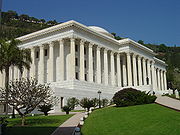 The Seat of the Universal House of Justice is the building located in Haifa
The Seat of the Universal House of Justice is the building located in Haifa
, Israel
where the Universal House of Justice
, the centre of the Bahá'í
covenant, sits. It is a large building where the House of Justice can meet dignitaries and pilgrims, and attend to other business. It also houses a few other offices of the Bahá'í World Centre
.
Located at the apex of The Arc
and built with sixty Corinthian columns around it to mirror the design of the International Archives. The architect was Hossein Amanat
and it was completed in 1982 during the second stage of building on the Arc, to be occupied in 1983.
During a Bahá'í pilgrimage the members of the Universal House of Justice greet each of the pilgrims in turn before they are shown around main areas of the building.
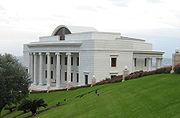 Built in the third stage of the building of the Arc
Built in the third stage of the building of the Arc
, the Seat of the International Teaching Centre is where the International Teaching Centre
is based. The architect was Hossein Amanat
and it was completed in 2001.
 Built in the third stage of the building of the Arc
Built in the third stage of the building of the Arc
, the Centre for the Study of the Sacred Texts is the base of the scholars and translators who study and translate the Bahá'í
texts to assist the Universal House of Justice
. The architect was Hossein Amanat
and it was completed in 1999.
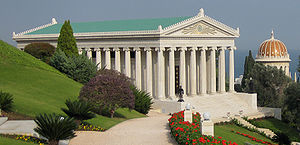 The International Archives is the first building to be built on the Arc
The International Archives is the first building to be built on the Arc
and holds many of the most sacred items within the Bahá'í Faith
, but most importantly is built for the viewing of the paintings and drawings of Bahá'u'lláh
and the Báb
, along with a single photograph of Bahá'u'lláh. Although some of these items are available on the internet today, most Bahá'ís prefer to see these items only in a reverent atmosphere, during the pilgrimage
.
Shoghi Effendi
chose the Parthenon
as the basis for the design, possibly due to the apparent enduring beauty even after thousands of years. The capitals of the fifty columns were Ionic rather than the Doric Order. It was finished in 1957 however Shoghi Effendi never lived to furnish the interior. This was left to his wife Rúhíyyih Khanum
.
Previously the rear three rooms of the Shrine of the Báb
and then the building beside the Monument Gardens now called the Department of Holy Places were temporary Archives buildings.
is as of yet unbuilt. The Bahá'í World Centre Library holds an extensive collection of Bahá'í literature
. The Universal House of Justice stated: "In future decades its functions must grow, it will serve as an active centre for knowledge in all fields, and it will become the kernel of great institutions of scientific investigation and discovery."
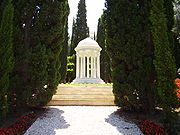
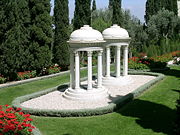
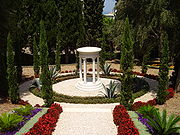 The Monument Gardens within the Bahá'í World Centre
The Monument Gardens within the Bahá'í World Centre
are a set of gardens which hold the graves of some of the members of the Bahá'í holy family:

The Terraces are garden terraces that form nine above and nine below the Shrine of the Báb
on Mount Carmel within Haifa
, Israel
.
Nine concentric circles thus provide the main geometry of the eighteen terraces. Just as the identification of a circle presupposes a centre, so the terraces have been conceived as generated from the Shrine of the Báb. The eighteen terraces plus the one terrace of the Shrine of the Báb make nineteen terraces total. Nineteen is a significant number within both the Bahá'í and Bábí religions.
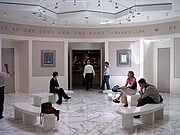 The Visitors Centre is an underground structure on the 11th terrace behind the Shrine of the Báb
The Visitors Centre is an underground structure on the 11th terrace behind the Shrine of the Báb
on Mount Carmel within Haifa
, Israel
. It can be found on street level under the Hatzionut Bridge which the terraces pass over.
from 1892 to 1921, designed and built a house in Haifa
on 7 Haparsim (Persian) Street after his father Bahá'u'lláh
died. It was completed in 1908, and `Abdu'l-Bahá
moved to the house in August 1910. It became his official residence. After his travels to the West, it became the place for the reception of pilgrims
to the Bahá'í World Centre
.
to the Bahá'í holy places. There have been numerous buildings within Haifa
, Israel
dedicated to this throughout the last century.
of Western origin, who had come for pilgrimage during the early years of the 20th century, before it was replaced by the new Western Pilgrim House on 10 Haparsim Street.
The house is currently part of the Bahá'í World Centre
. While it was originally rented to serve as a Pilgrim House, the house was then bought by `Abdu'l-Bahá
. After being replaced by new Western Pilgrim House, the site was then used by members of the Bahá'í holy family. It left Bahá'í hands shortly before being re-bought by the Universal House of Justice
.
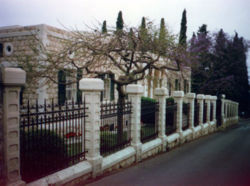 The second Western Pilgrim House, often referred to as "the old western Pilgrim House", located at 10 Haparsim (Persian) Street in Haifa, Israel, was used as a Pilgrim House for members of the Bahá'í Faith who had come for pilgrimage during the first half of the 20th century. It is currently part of the Bahá'í World Centre
The second Western Pilgrim House, often referred to as "the old western Pilgrim House", located at 10 Haparsim (Persian) Street in Haifa, Israel, was used as a Pilgrim House for members of the Bahá'í Faith who had come for pilgrimage during the first half of the 20th century. It is currently part of the Bahá'í World Centre
and used by the Bahá'í International Community Secretariat and related offices.
The house was originally paid for by William Harry Randall, a wealthy American Bahá'í, who felt the facilities of the previous Western Pilgrim House at 4 Haparsim were inadequate. Its construction was started under the instruction of `Abdu'l-Bahá
, but was only completed during the time that Shoghi Effendi
was the Guardian of the Bahá'í Faith. Although it served originally as the Pilgrim House for western Bahá'ís, it has been used for other purposes more recently:
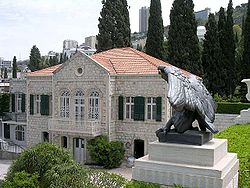 The Eastern Pilgrim House or the "Haifa Pilgrim House" is a Pilgrim House for Bahá'ís when they go on pilgrimage. The house was built after `Abdu'l-Bahá
The Eastern Pilgrim House or the "Haifa Pilgrim House" is a Pilgrim House for Bahá'ís when they go on pilgrimage. The house was built after `Abdu'l-Bahá
interred the remains of the Báb
on Mount Carmel. The construction of this stone building was supervised Mírzá Ja’far Rahmání of 'Ishqábád, who also paid all the expenses. It is known as the "Eastern Pilgrim House", as for decades it housed the Persian
pilgrims. After 1951, when the Western Pilgrim House at 10 Haparsim Street became the seat of the International Bahá'í Council
, it became the Pilgrim House for all pilgrims.
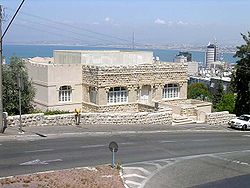 The Pilgrim Reception Centre or the "Haifa Pilgrim Reception Centre" is the newest Pilgrim Reception Centre for pilgrimage to sites near the Bahá'í World Centre. It comprises two conjoined buildings, of a historic medical clinic, that have recently been remodeled and opened in October 2000. The building can serve up to 500 people on pilgrimage.
The Pilgrim Reception Centre or the "Haifa Pilgrim Reception Centre" is the newest Pilgrim Reception Centre for pilgrimage to sites near the Bahá'í World Centre. It comprises two conjoined buildings, of a historic medical clinic, that have recently been remodeled and opened in October 2000. The building can serve up to 500 people on pilgrimage.
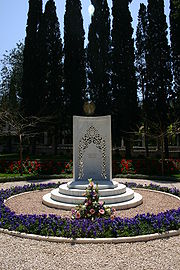 The Resting place of Amatu'l-Bahá Rúhíyyih Khanum is situated within Haifa, Israel as part of the Bahá'í World Centre
The Resting place of Amatu'l-Bahá Rúhíyyih Khanum is situated within Haifa, Israel as part of the Bahá'í World Centre
. Originally bought to make sure that the area around the House of `Abdu'l-Bahá was not built up, and used as a garden, it was selected as the burial ground for Amatu'l-Bahá Rúhíyyih Khanum after she died in 2000.
that is not particularly celebrated but has been an integral part of the centre for many years. Amongst other things it has been used for:
It is currently used as the Bahá'í "Department of Holy Places".
 Another structure in the Haifa region is the site of the future Mashriqu'l-Adhkár.
Another structure in the Haifa region is the site of the future Mashriqu'l-Adhkár.
, and his family, was exiled to the prison city of Akká
by the Ottoman Sultan Abd-ul-Aziz. Bahá'u'lláh arrived in Akká on August 31, 1868, and lived the rest of his life in the Akká area as a prisoner. His prison conditions were eased in June 1877 and while still a prisoner, he moved to Mazra'ih at that time. The Bahá'í buildings and property in Akká were rented or bought during this period of time.
 The House of `Abbúd refers actually to two houses:
The House of `Abbúd refers actually to two houses:
The house provided a home for Bahá'u'lláh's first wife Navváb
and her family. It was in this building that the Kitáb-i-Aqdas
was written.
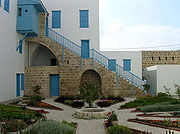 The House of `Abdu'lláh Páshá is one of the properties the Bahá'í
The House of `Abdu'lláh Páshá is one of the properties the Bahá'í
holy family used in the Akká area. It was acquired by `Abdu'l-Bahá
to fit the growing family and also provide space to welcome pilgrims who had started to arrive.
The name derives from the Akká
governor Ibrahim Pasha
who owned the house in the early decades of the 19th century.
The first western pilgrims were welcomed here on December 10, 1898.
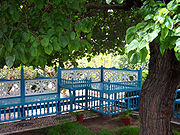 The Garden of Ridván (lit. garden of paradise) is a Bahá'í
The Garden of Ridván (lit. garden of paradise) is a Bahá'í
holy place situated just outside Akká within modern Israel
. Originally known as the 'garden of Na‘mayn', it was rented by `Abdu'l-Bahá
for Bahá'u'lláh
where he enjoyed spending the later part of his life, after years in a desolute prison cell. Although it shares the same name it does not have the same significance of the Garden of Ridván, Baghdad
and no connection to the festival of Ridván
.
During the 1930s and 1940s the island setting of the garden disappeared, as a result of a draining project against malaria. In 2010 a three year restoration and conservation project of the garden and the original water canals surrounding it was completed, after which the Ridvan Garden, referred to by Bahá'u'lláh as 'Our Verdant Isle', became an island once again.
 The prison cell in which Bahá'u'lláh
The prison cell in which Bahá'u'lláh
lived between 1868 and 1870 has now become a Bahá'í pilgrimage location. Its restoration was completed in June 2004.
, where Bahá'u'lláh spent his final years of life. While he was still formally a prisoner of the Ottoman Empire, his prison conditions were eased, and in 1879 he used the Mansion of Bahjí as his summer home.
Although the Mansion of Bahjí is relatively isolated with only a small pilgrim house and the shrine within several hundred metres, there used to be a complex of several buildings mostly used by the extended Holy family. During the time of Shoghi Effendi
, these buildings (and the land around them which are used as gardens) were bought up or traded for land near the Sea of Galilee
. Most of these buildings were flattened as they had been used by covenant breakers. The tiles off the roofs were used to make the pathways and the rest of the buildings were used to make a large windbreak to the south west of the Mansion.
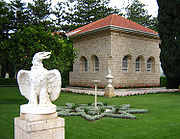
Located in Bahjí the Shrine of Bahá'u'lláh is the most holy place for Bahá'ís
— their Qiblih
. It contains the remains of Bahá'u'lláh
and is near the spot where he died in the Mansion of Bahjí.
 The Mansion of Bahjí is a term used to describe the summer house where Bahá'u'lláh
The Mansion of Bahjí is a term used to describe the summer house where Bahá'u'lláh
died in 1892. It was built in 1870 over an earlier, smaller building by `Udi Khammar, a wealthy merchant from Akká who was also the original owner of the House of `Abbúd. It remained in his family's hands until 1879, when an epidemic caused the inhabitants to flee. The mansion was subsequently rented to the Bahá'í
holy family for a very small amount of money. `Udi Khammar's tomb is still within the main Mansion compound, on the northwest corner of the wall. It is now a Bahá'í pilgrimage
site.
 Located near Bahjí and the Shrine of Bahá'u'lláh, it is the pilgrim visitor centre for the most holy place for Bahá'ís
Located near Bahjí and the Shrine of Bahá'u'lláh, it is the pilgrim visitor centre for the most holy place for Bahá'ís
.
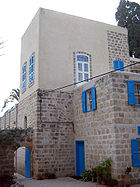 Located four miles (6 km) north of Akká
Located four miles (6 km) north of Akká
in Mazra'a
, Bahá'u'lláh used this country house during the summers from June 1877 until 1879, before moving to a larger summer house within Bahjí. It left Bahá'í hands for several decades and was slightly restructured with an annex added to the front. This meant that a staircase, previously on the outside is now within the house's walls. It originally belonged to `Abdu'lláh Páshá, and is located four miles (6 km) north of Akká
.
Bahá'í World Centre
The Bahá'í World Centre is the name given to the spiritual and administrative centre of the Bahá'í Faith. The World Centre consists of the Shrine of Bahá'u'lláh near Acre, Israel, the Shrine of the Báb and its gardens on Mount Carmel in Haifa, Israel, and various other buildings in the area...
in Israel
Israel
The State of Israel is a parliamentary republic located in the Middle East, along the eastern shore of the Mediterranean Sea...
. The Bahá'í World Centre buildings include both the Bahá'í holy places used for pilgrimage
Bahá'í pilgrimage
A Bahá'í pilgrimage currently consists of visiting the holy places in Haifa, Akká, and Bahjí at the Bahá'í World Centre in Northwest Israel. Bahá'ís do not have access to other places designated as sites for pilgrimage....
and the international administrative bodies of the Bahá'í Faith
Bahá'í Faith
The Bahá'í Faith is a monotheistic religion founded by Bahá'u'lláh in 19th-century Persia, emphasizing the spiritual unity of all humankind. There are an estimated five to six million Bahá'ís around the world in more than 200 countries and territories....
; they comprise more than 20 different administrative offices, pilgrim buildings, libraries, archives, historical residences, and shrines. These structures are all set amidst more than 30 different gardens or individual terraces.
The buildings themselves are located in Haifa
Haifa
Haifa is the largest city in northern Israel, and the third-largest city in the country, with a population of over 268,000. Another 300,000 people live in towns directly adjacent to the city including the cities of the Krayot, as well as, Tirat Carmel, Daliyat al-Karmel and Nesher...
, Acre
Acre, Israel
Acre , is a city in the Western Galilee region of northern Israel at the northern extremity of Haifa Bay. Acre is one of the oldest continuously inhabited sites in the country....
, and Bahjí, Israel. The location of the Bahá'í World Centre buildings has its roots to Bahá'u'lláh
Bahá'u'lláh
Bahá'u'lláh , born ' , was the founder of the Bahá'í Faith. He claimed to be the prophetic fulfilment of Bábism, a 19th-century outgrowth of Shí‘ism, but in a broader sense claimed to be a messenger from God referring to the fulfilment of the eschatological expectations of Islam, Christianity, and...
's imprisonment in Acre, which is near Haifa, by the Ottoman Empire
Ottoman Empire
The Ottoman EmpireIt was usually referred to as the "Ottoman Empire", the "Turkish Empire", the "Ottoman Caliphate" or more commonly "Turkey" by its contemporaries...
during the Ottoman Empire's rule over Palestine
Palestine
Palestine is a conventional name, among others, used to describe the geographic region between the Mediterranean Sea and the Jordan River, and various adjoining lands....
, now Israel
Israel
The State of Israel is a parliamentary republic located in the Middle East, along the eastern shore of the Mediterranean Sea...
.
Many Bahá'í holy places in Haifa
Haifa
Haifa is the largest city in northern Israel, and the third-largest city in the country, with a population of over 268,000. Another 300,000 people live in towns directly adjacent to the city including the cities of the Krayot, as well as, Tirat Carmel, Daliyat al-Karmel and Nesher...
and around Acre
Acre, Israel
Acre , is a city in the Western Galilee region of northern Israel at the northern extremity of Haifa Bay. Acre is one of the oldest continuously inhabited sites in the country....
, including the terraces and the Shrine of the Báb
Shrine of the Báb
The Shrine of the Báb is a structure in Haifa, Israel where the remains of the Báb, founder of Bábism and forerunner of Bahá'u'lláh in the Bahá'í Faith, have been laid to rest; it is considered to be the second holiest place on Earth for Bahá'ís, after the Shrine of Bahá'u'lláh in Acre...
on the north slope on Mount Carmel
Mount Carmel
Mount Carmel ; , Kármēlos; , Kurmul or جبل مار إلياس Jabal Mar Elyas 'Mount Saint Elias') is a coastal mountain range in northern Israel stretching from the Mediterranean Sea towards the southeast. Archaeologists have discovered ancient wine and oil presses at various locations on Mt. Carmel...
, and the Shrine of Bahá'u'lláh, the Mansion of Bahji, and the Mansion at Mazra'ih were inscribed on the World Heritage List in July 2008. The Bahá'í shrines "are the first sites connected with a relatively new religious tradition to be recognized by the World Heritage List." The UNESCO World Heritage Committee considers the sites to be "of outstanding universal value [and]...inscribed for the testimony they provide to the Bahá’i’s strong tradition of pilgrimage and for their profound meaning for the faith."
Haifa
HaifaHaifa
Haifa is the largest city in northern Israel, and the third-largest city in the country, with a population of over 268,000. Another 300,000 people live in towns directly adjacent to the city including the cities of the Krayot, as well as, Tirat Carmel, Daliyat al-Karmel and Nesher...
is the third-largest city in Israel
Israel
The State of Israel is a parliamentary republic located in the Middle East, along the eastern shore of the Mediterranean Sea...
, and it is a seaport, located below and on Mount Carmel, and lies on the Mediterranean coast. In 1891 Bahá'u'lláh
Bahá'u'lláh
Bahá'u'lláh , born ' , was the founder of the Bahá'í Faith. He claimed to be the prophetic fulfilment of Bábism, a 19th-century outgrowth of Shí‘ism, but in a broader sense claimed to be a messenger from God referring to the fulfilment of the eschatological expectations of Islam, Christianity, and...
himself designated Mount Carmel as the location for the Shrine of the Báb
Shrine of the Báb
The Shrine of the Báb is a structure in Haifa, Israel where the remains of the Báb, founder of Bábism and forerunner of Bahá'u'lláh in the Bahá'í Faith, have been laid to rest; it is considered to be the second holiest place on Earth for Bahá'ís, after the Shrine of Bahá'u'lláh in Acre...
. Later, Bahá'u'lláh in the Tablet of Carmel wrote that Mount Carmel would be the physical location of the Bahá'í World Centre
Bahá'í World Centre
The Bahá'í World Centre is the name given to the spiritual and administrative centre of the Bahá'í Faith. The World Centre consists of the Shrine of Bahá'u'lláh near Acre, Israel, the Shrine of the Báb and its gardens on Mount Carmel in Haifa, Israel, and various other buildings in the area...
.
The Shrine of the Báb

Báb
Siyyid `Alí Muḥammad Shírází was the founder of Bábism, and one of three central figures of the Bahá'í Faith. He was a merchant from Shíráz, Persia, who at the age of twenty-four claimed to be the promised Qá'im . After his declaration he took the title of Báb meaning "Gate"...
's remains have been laid to rest. The location was designated by Bahá'u'lláh
Bahá'u'lláh
Bahá'u'lláh , born ' , was the founder of the Bahá'í Faith. He claimed to be the prophetic fulfilment of Bábism, a 19th-century outgrowth of Shí‘ism, but in a broader sense claimed to be a messenger from God referring to the fulfilment of the eschatological expectations of Islam, Christianity, and...
himself in 1891 while he was camped, with `Abdu'l-Bahá
`Abdu'l-Bahá
‘Abdu’l-Bahá , born ‘Abbás Effendí, was the eldest son of Bahá'u'lláh, the founder of the Bahá'í Faith. In 1892, `Abdu'l-Bahá was appointed in his father's will to be his successor and head of the Bahá'í Faith. `Abdu'l-Bahá was born in Tehran to an aristocratic family of the realm...
, across from Mount Carmel
Mount Carmel
Mount Carmel ; , Kármēlos; , Kurmul or جبل مار إلياس Jabal Mar Elyas 'Mount Saint Elias') is a coastal mountain range in northern Israel stretching from the Mediterranean Sea towards the southeast. Archaeologists have discovered ancient wine and oil presses at various locations on Mt. Carmel...
. The location is right above the German Colony
German Colony, Haifa
The German Colony was established in Haifa in 1868 by the German Templers. It was the first of several colonies established by the group in the Holy Land...
, which was established in the 1860s by the German Templer Society
Templers (religious believers)
Templers are members of the Temple Society , a German Protestant sect with roots in the Pietist movement of the Lutheran Church. The Templers were expelled from the church in 1858 because of their millennial beliefs. Their aim was to realize the apocalyptic visions of the prophets of Israel in the...
, who were working for the Kingdom of God
Kingdom of God
The Kingdom of God or Kingdom of Heaven is a foundational concept in the Abrahamic religions: Judaism, Christianity and Islam.The term "Kingdom of God" is found in all four canonical gospels and in the Pauline epistles...
on earth. The shrine was built by `Abdu'l-Bahá in 1909. Many years later, the superstructure was completed by Shoghi Effendi
Shoghi Effendi
Shoghí Effendí Rabbání , better known as Shoghi Effendi, was the Guardian and appointed head of the Bahá'í Faith from 1921 until his death in 1957...
, and finally dedicated in 1953.
The architect
Architect
An architect is a person trained in the planning, design and oversight of the construction of buildings. To practice architecture means to offer or render services in connection with the design and construction of a building, or group of buildings and the space within the site surrounding the...
was William Sutherland Maxwell
William Sutherland Maxwell
William Sutherland Maxwell was a well-known Canadian architect and a Hand of the Cause in the Bahá'í Faith. He was born in Montreal, Canada to parents Edward John Maxwell and Johan MacBean.-Education:...
, a Canadian
Canada
Canada is a North American country consisting of ten provinces and three territories. Located in the northern part of the continent, it extends from the Atlantic Ocean in the east to the Pacific Ocean in the west, and northward into the Arctic Ocean...
Bahá'í who was a Beaux-Arts architect and the father-in-law of Shoghi Effendi. Shoghi Effendi provided overall guidance, including in the use of Western and Eastern styles, but left the artistic details to Maxwell. Maxwell's design of the Rose Baveno granite colonnade, Oriental-style Chiampo stone arches, and golden dome is meant to harmonize Eastern and Western proportions and style. Some remaining aspects of the dome's structural engineering were designed by Professor H. Neumann of Haifa's Technion University.
After Maxwell died in 1952, Leroy Ioas
Leroy Ioas
Leroy C Ioas was a Hand of the Cause of the Bahá'í Faith. His parents declared themselves Bahá'ís in 1898 and took Ioas to meet `Abdu'l-Bahá during the latter’s travels in the United States in 1912...
, an American Bahá'í who had been closely associated with the construction of the Bahá'í House of Worship
Bahá'í House of Worship
A Bahá'í House of Worship, sometimes referred to by its Arabic name of Mashriqu'l-Adhkár ,is the designation of a place of worship, or temple, of the Bahá'í Faith...
in Wilmette, Illinois
Wilmette, Illinois
Wilmette is a village in New Trier Township, Cook County, Illinois, United States. It is located north of Chicago's downtown district and has a population of 27,651. Wilmette is considered a bedroom community in the North Shore district...
helped Shoghi Effendi in the construction process. Ioas employed his administrative skills and practical mind to supervise the building of the drum and dome, a task done without the availability of sophisticated machinery.
Temporary Shrine of `Abdu'l-Bahá
The Shrine of `Abdu'l-Bahá is the location where `Abdu'l-Bahá`Abdu'l-Bahá
‘Abdu’l-Bahá , born ‘Abbás Effendí, was the eldest son of Bahá'u'lláh, the founder of the Bahá'í Faith. In 1892, `Abdu'l-Bahá was appointed in his father's will to be his successor and head of the Bahá'í Faith. `Abdu'l-Bahá was born in Tehran to an aristocratic family of the realm...
's remains have been temporarily laid to rest. It is found in one of the rooms of the Shrine of the Báb; the Shrine of `Abdu'l-Bahá will be relocated to a new structure to be built in the future.
The Arc buildings
The Arc composes a number of administrative buildings as revealed by Bahá'u'lláhBahá'u'lláh
Bahá'u'lláh , born ' , was the founder of the Bahá'í Faith. He claimed to be the prophetic fulfilment of Bábism, a 19th-century outgrowth of Shí‘ism, but in a broader sense claimed to be a messenger from God referring to the fulfilment of the eschatological expectations of Islam, Christianity, and...
in the Tablet of Carmel, built in the shape of an ark which include, the Seat of the Universal House of Justice, the Seat of the International Teaching Centre, the International Bahá'í Archives and the Centre for the Study of the Sacred Texts. The fifth building, the International Bahá'í Library has yet to be built.
Seat of the Universal House of Justice

Haifa
Haifa is the largest city in northern Israel, and the third-largest city in the country, with a population of over 268,000. Another 300,000 people live in towns directly adjacent to the city including the cities of the Krayot, as well as, Tirat Carmel, Daliyat al-Karmel and Nesher...
, Israel
Israel
The State of Israel is a parliamentary republic located in the Middle East, along the eastern shore of the Mediterranean Sea...
where the Universal House of Justice
Universal House of Justice
The Universal House of Justice is the supreme governing institution of the Bahá'í Faith. It is a legislative institution with the authority to supplement and apply the laws of Bahá'u'lláh, the founder of the Bahá'í Faith, and exercises a judicial function as the highest appellate institution in the...
, the centre of the Bahá'í
Bahá'í Faith
The Bahá'í Faith is a monotheistic religion founded by Bahá'u'lláh in 19th-century Persia, emphasizing the spiritual unity of all humankind. There are an estimated five to six million Bahá'ís around the world in more than 200 countries and territories....
covenant, sits. It is a large building where the House of Justice can meet dignitaries and pilgrims, and attend to other business. It also houses a few other offices of the Bahá'í World Centre
Bahá'í World Centre
The Bahá'í World Centre is the name given to the spiritual and administrative centre of the Bahá'í Faith. The World Centre consists of the Shrine of Bahá'u'lláh near Acre, Israel, the Shrine of the Báb and its gardens on Mount Carmel in Haifa, Israel, and various other buildings in the area...
.
Located at the apex of The Arc
The Arc (Bahá'í)
The Arc is a number of Bahá'í administrative buildings at the Bahá'í World Centre on Mount Carmel located at Haifa, Israel. They include the Seat of the Universal House of Justice, the Seat of the International Teaching Centre, the International Archives, and the Centre for the Study of the Sacred...
and built with sixty Corinthian columns around it to mirror the design of the International Archives. The architect was Hossein Amanat
Hossein Amanat
Hossein Amanat is an Iranian-Canadian architect. He is best known for being the architect of the Azadi Tower in Tehran, Iran, and the Bahá'í Arc buildings in Haifa, Israel. He is a Bahá'í.- Practice :...
and it was completed in 1982 during the second stage of building on the Arc, to be occupied in 1983.
During a Bahá'í pilgrimage the members of the Universal House of Justice greet each of the pilgrims in turn before they are shown around main areas of the building.
Seat of the International Teaching Centre

The Arc (Bahá'í)
The Arc is a number of Bahá'í administrative buildings at the Bahá'í World Centre on Mount Carmel located at Haifa, Israel. They include the Seat of the Universal House of Justice, the Seat of the International Teaching Centre, the International Archives, and the Centre for the Study of the Sacred...
, the Seat of the International Teaching Centre is where the International Teaching Centre
International Teaching Centre
The International Teaching Centre is a Bahá'í institution based in the Bahá'í World Centre in Haifa, Israel...
is based. The architect was Hossein Amanat
Hossein Amanat
Hossein Amanat is an Iranian-Canadian architect. He is best known for being the architect of the Azadi Tower in Tehran, Iran, and the Bahá'í Arc buildings in Haifa, Israel. He is a Bahá'í.- Practice :...
and it was completed in 2001.
Centre for the Study of the Sacred Texts

The Arc (Bahá'í)
The Arc is a number of Bahá'í administrative buildings at the Bahá'í World Centre on Mount Carmel located at Haifa, Israel. They include the Seat of the Universal House of Justice, the Seat of the International Teaching Centre, the International Archives, and the Centre for the Study of the Sacred...
, the Centre for the Study of the Sacred Texts is the base of the scholars and translators who study and translate the Bahá'í
Bahá'í Faith
The Bahá'í Faith is a monotheistic religion founded by Bahá'u'lláh in 19th-century Persia, emphasizing the spiritual unity of all humankind. There are an estimated five to six million Bahá'ís around the world in more than 200 countries and territories....
texts to assist the Universal House of Justice
Universal House of Justice
The Universal House of Justice is the supreme governing institution of the Bahá'í Faith. It is a legislative institution with the authority to supplement and apply the laws of Bahá'u'lláh, the founder of the Bahá'í Faith, and exercises a judicial function as the highest appellate institution in the...
. The architect was Hossein Amanat
Hossein Amanat
Hossein Amanat is an Iranian-Canadian architect. He is best known for being the architect of the Azadi Tower in Tehran, Iran, and the Bahá'í Arc buildings in Haifa, Israel. He is a Bahá'í.- Practice :...
and it was completed in 1999.
International Archives

The Arc (Bahá'í)
The Arc is a number of Bahá'í administrative buildings at the Bahá'í World Centre on Mount Carmel located at Haifa, Israel. They include the Seat of the Universal House of Justice, the Seat of the International Teaching Centre, the International Archives, and the Centre for the Study of the Sacred...
and holds many of the most sacred items within the Bahá'í Faith
Bahá'í Faith
The Bahá'í Faith is a monotheistic religion founded by Bahá'u'lláh in 19th-century Persia, emphasizing the spiritual unity of all humankind. There are an estimated five to six million Bahá'ís around the world in more than 200 countries and territories....
, but most importantly is built for the viewing of the paintings and drawings of Bahá'u'lláh
Bahá'u'lláh
Bahá'u'lláh , born ' , was the founder of the Bahá'í Faith. He claimed to be the prophetic fulfilment of Bábism, a 19th-century outgrowth of Shí‘ism, but in a broader sense claimed to be a messenger from God referring to the fulfilment of the eschatological expectations of Islam, Christianity, and...
and the Báb
Báb
Siyyid `Alí Muḥammad Shírází was the founder of Bábism, and one of three central figures of the Bahá'í Faith. He was a merchant from Shíráz, Persia, who at the age of twenty-four claimed to be the promised Qá'im . After his declaration he took the title of Báb meaning "Gate"...
, along with a single photograph of Bahá'u'lláh. Although some of these items are available on the internet today, most Bahá'ís prefer to see these items only in a reverent atmosphere, during the pilgrimage
Bahá'í pilgrimage
A Bahá'í pilgrimage currently consists of visiting the holy places in Haifa, Akká, and Bahjí at the Bahá'í World Centre in Northwest Israel. Bahá'ís do not have access to other places designated as sites for pilgrimage....
.
Shoghi Effendi
Shoghi Effendi
Shoghí Effendí Rabbání , better known as Shoghi Effendi, was the Guardian and appointed head of the Bahá'í Faith from 1921 until his death in 1957...
chose the Parthenon
Parthenon
The Parthenon is a temple on the Athenian Acropolis, Greece, dedicated to the Greek goddess Athena, whom the people of Athens considered their virgin patron. Its construction began in 447 BC when the Athenian Empire was at the height of its power. It was completed in 438 BC, although...
as the basis for the design, possibly due to the apparent enduring beauty even after thousands of years. The capitals of the fifty columns were Ionic rather than the Doric Order. It was finished in 1957 however Shoghi Effendi never lived to furnish the interior. This was left to his wife Rúhíyyih Khanum
Rúhíyyih Khanum
Amatu'l-Bahá Rúhíyyih Khánum , born Mary Sutherland Maxwell was the wife of Shoghi Effendi, the head of the Bahá'í Faith from 1921–1957. She was appointed by him as a Hand of the Cause, and served an important role in the transfer of authority from 1957–1963...
.
Previously the rear three rooms of the Shrine of the Báb
Shrine of the Báb
The Shrine of the Báb is a structure in Haifa, Israel where the remains of the Báb, founder of Bábism and forerunner of Bahá'u'lláh in the Bahá'í Faith, have been laid to rest; it is considered to be the second holiest place on Earth for Bahá'ís, after the Shrine of Bahá'u'lláh in Acre...
and then the building beside the Monument Gardens now called the Department of Holy Places were temporary Archives buildings.
International Bahá'í Library
The International Bahá'í Library Building instructed by Shoghi EffendiShoghi Effendi
Shoghí Effendí Rabbání , better known as Shoghi Effendi, was the Guardian and appointed head of the Bahá'í Faith from 1921 until his death in 1957...
is as of yet unbuilt. The Bahá'í World Centre Library holds an extensive collection of Bahá'í literature
Bahá'í literature
Bahá'í literature, like much religious text, covers a variety of topics and forms, including scripture and inspiration, interpretation, history and biography, introduction and study materials, and apologia...
. The Universal House of Justice stated: "In future decades its functions must grow, it will serve as an active centre for knowledge in all fields, and it will become the kernel of great institutions of scientific investigation and discovery."
Monument Gardens



Bahá'í World Centre
The Bahá'í World Centre is the name given to the spiritual and administrative centre of the Bahá'í Faith. The World Centre consists of the Shrine of Bahá'u'lláh near Acre, Israel, the Shrine of the Báb and its gardens on Mount Carmel in Haifa, Israel, and various other buildings in the area...
are a set of gardens which hold the graves of some of the members of the Bahá'í holy family:
- Mirzá MihdíMírzá MihdíMírzá Mihdí , given the title Ghusn-i-Athar . Mírzá Mihdí was born Mihdí Núrí in Tehran, and named after a deceased brother of his father.-Biography:...
— Bahá'u'lláh's youngest son from his first wife - Ásiyih KhánumÁsíyih KhánumÁsíyih Khánum was the wife of Bahá'u'lláh, the founder of the Bahá'í Faith. She is viewed by Bahá’ís as the paragon of a devoted mother and wife. She is also known by her titles of Navváb, the Most Exalted Leaf, Búyúk Khánum or Hadrat-i-Khánum. Khánum, is a title usually given to a Persian lady...
— Bahá'u'lláh's first wife - Bahíyyih KhánumBahiyyih KhánumBahíyyih Khánum the only daughter of Bahá'u'lláh, the founder of the Bahá'í Faith, and Ásíyih Khánum. She was born in 1846 with the given name Fatimih Sultan, and was entitled "Varaqiy-i-'Ulyá" or "Greatest Holy Leaf"...
— Bahá'u'lláh's daughter - Munirih KhánumMunirih KhánumMunírih Khánum was the wife of `Abdu'l-Bahá, the son of the founder of the Bahá'í Faith, Bahá'u'lláh. She was entitled the Holy Mother...
— `Abdu'l-Bahá's wife
The Terraces

The Terraces are garden terraces that form nine above and nine below the Shrine of the Báb
Shrine of the Báb
The Shrine of the Báb is a structure in Haifa, Israel where the remains of the Báb, founder of Bábism and forerunner of Bahá'u'lláh in the Bahá'í Faith, have been laid to rest; it is considered to be the second holiest place on Earth for Bahá'ís, after the Shrine of Bahá'u'lláh in Acre...
on Mount Carmel within Haifa
Haifa
Haifa is the largest city in northern Israel, and the third-largest city in the country, with a population of over 268,000. Another 300,000 people live in towns directly adjacent to the city including the cities of the Krayot, as well as, Tirat Carmel, Daliyat al-Karmel and Nesher...
, Israel
Israel
The State of Israel is a parliamentary republic located in the Middle East, along the eastern shore of the Mediterranean Sea...
.
Nine concentric circles thus provide the main geometry of the eighteen terraces. Just as the identification of a circle presupposes a centre, so the terraces have been conceived as generated from the Shrine of the Báb. The eighteen terraces plus the one terrace of the Shrine of the Báb make nineteen terraces total. Nineteen is a significant number within both the Bahá'í and Bábí religions.
The Visitors Centre

Shrine of the Báb
The Shrine of the Báb is a structure in Haifa, Israel where the remains of the Báb, founder of Bábism and forerunner of Bahá'u'lláh in the Bahá'í Faith, have been laid to rest; it is considered to be the second holiest place on Earth for Bahá'ís, after the Shrine of Bahá'u'lláh in Acre...
on Mount Carmel within Haifa
Haifa
Haifa is the largest city in northern Israel, and the third-largest city in the country, with a population of over 268,000. Another 300,000 people live in towns directly adjacent to the city including the cities of the Krayot, as well as, Tirat Carmel, Daliyat al-Karmel and Nesher...
, Israel
Israel
The State of Israel is a parliamentary republic located in the Middle East, along the eastern shore of the Mediterranean Sea...
. It can be found on street level under the Hatzionut Bridge which the terraces pass over.
The House of `Abdu'l-Bahá
`Abdu'l-Bahá, who was the head of the Bahá'í FaithBahá'í Faith
The Bahá'í Faith is a monotheistic religion founded by Bahá'u'lláh in 19th-century Persia, emphasizing the spiritual unity of all humankind. There are an estimated five to six million Bahá'ís around the world in more than 200 countries and territories....
from 1892 to 1921, designed and built a house in Haifa
Haifa
Haifa is the largest city in northern Israel, and the third-largest city in the country, with a population of over 268,000. Another 300,000 people live in towns directly adjacent to the city including the cities of the Krayot, as well as, Tirat Carmel, Daliyat al-Karmel and Nesher...
on 7 Haparsim (Persian) Street after his father Bahá'u'lláh
Bahá'u'lláh
Bahá'u'lláh , born ' , was the founder of the Bahá'í Faith. He claimed to be the prophetic fulfilment of Bábism, a 19th-century outgrowth of Shí‘ism, but in a broader sense claimed to be a messenger from God referring to the fulfilment of the eschatological expectations of Islam, Christianity, and...
died. It was completed in 1908, and `Abdu'l-Bahá
`Abdu'l-Bahá
‘Abdu’l-Bahá , born ‘Abbás Effendí, was the eldest son of Bahá'u'lláh, the founder of the Bahá'í Faith. In 1892, `Abdu'l-Bahá was appointed in his father's will to be his successor and head of the Bahá'í Faith. `Abdu'l-Bahá was born in Tehran to an aristocratic family of the realm...
moved to the house in August 1910. It became his official residence. After his travels to the West, it became the place for the reception of pilgrims
Bahá'í pilgrimage
A Bahá'í pilgrimage currently consists of visiting the holy places in Haifa, Akká, and Bahjí at the Bahá'í World Centre in Northwest Israel. Bahá'ís do not have access to other places designated as sites for pilgrimage....
to the Bahá'í World Centre
Bahá'í World Centre
The Bahá'í World Centre is the name given to the spiritual and administrative centre of the Bahá'í Faith. The World Centre consists of the Shrine of Bahá'u'lláh near Acre, Israel, the Shrine of the Báb and its gardens on Mount Carmel in Haifa, Israel, and various other buildings in the area...
.
Pilgrim Houses
Pilgrim Houses signify buildings where pilgrims are (or were) greeted and housed during pilgrimageBahá'í pilgrimage
A Bahá'í pilgrimage currently consists of visiting the holy places in Haifa, Akká, and Bahjí at the Bahá'í World Centre in Northwest Israel. Bahá'ís do not have access to other places designated as sites for pilgrimage....
to the Bahá'í holy places. There have been numerous buildings within Haifa
Haifa
Haifa is the largest city in northern Israel, and the third-largest city in the country, with a population of over 268,000. Another 300,000 people live in towns directly adjacent to the city including the cities of the Krayot, as well as, Tirat Carmel, Daliyat al-Karmel and Nesher...
, Israel
Israel
The State of Israel is a parliamentary republic located in the Middle East, along the eastern shore of the Mediterranean Sea...
dedicated to this throughout the last century.
Original Western Pilgrim House
The original Western Pilgrim House, located at 4 Haparsim (Persian) Street in Haifa, Israel, was used as a Pilgrim House for members of the Bahá'í FaithBahá'í Faith
The Bahá'í Faith is a monotheistic religion founded by Bahá'u'lláh in 19th-century Persia, emphasizing the spiritual unity of all humankind. There are an estimated five to six million Bahá'ís around the world in more than 200 countries and territories....
of Western origin, who had come for pilgrimage during the early years of the 20th century, before it was replaced by the new Western Pilgrim House on 10 Haparsim Street.
The house is currently part of the Bahá'í World Centre
Bahá'í World Centre
The Bahá'í World Centre is the name given to the spiritual and administrative centre of the Bahá'í Faith. The World Centre consists of the Shrine of Bahá'u'lláh near Acre, Israel, the Shrine of the Báb and its gardens on Mount Carmel in Haifa, Israel, and various other buildings in the area...
. While it was originally rented to serve as a Pilgrim House, the house was then bought by `Abdu'l-Bahá
`Abdu'l-Bahá
‘Abdu’l-Bahá , born ‘Abbás Effendí, was the eldest son of Bahá'u'lláh, the founder of the Bahá'í Faith. In 1892, `Abdu'l-Bahá was appointed in his father's will to be his successor and head of the Bahá'í Faith. `Abdu'l-Bahá was born in Tehran to an aristocratic family of the realm...
. After being replaced by new Western Pilgrim House, the site was then used by members of the Bahá'í holy family. It left Bahá'í hands shortly before being re-bought by the Universal House of Justice
Universal House of Justice
The Universal House of Justice is the supreme governing institution of the Bahá'í Faith. It is a legislative institution with the authority to supplement and apply the laws of Bahá'u'lláh, the founder of the Bahá'í Faith, and exercises a judicial function as the highest appellate institution in the...
.
Second Western Pilgrim House

Bahá'í World Centre
The Bahá'í World Centre is the name given to the spiritual and administrative centre of the Bahá'í Faith. The World Centre consists of the Shrine of Bahá'u'lláh near Acre, Israel, the Shrine of the Báb and its gardens on Mount Carmel in Haifa, Israel, and various other buildings in the area...
and used by the Bahá'í International Community Secretariat and related offices.
The house was originally paid for by William Harry Randall, a wealthy American Bahá'í, who felt the facilities of the previous Western Pilgrim House at 4 Haparsim were inadequate. Its construction was started under the instruction of `Abdu'l-Bahá
`Abdu'l-Bahá
‘Abdu’l-Bahá , born ‘Abbás Effendí, was the eldest son of Bahá'u'lláh, the founder of the Bahá'í Faith. In 1892, `Abdu'l-Bahá was appointed in his father's will to be his successor and head of the Bahá'í Faith. `Abdu'l-Bahá was born in Tehran to an aristocratic family of the realm...
, but was only completed during the time that Shoghi Effendi
Shoghi Effendi
Shoghí Effendí Rabbání , better known as Shoghi Effendi, was the Guardian and appointed head of the Bahá'í Faith from 1921 until his death in 1957...
was the Guardian of the Bahá'í Faith. Although it served originally as the Pilgrim House for western Bahá'ís, it has been used for other purposes more recently:
- From 1951 to 1963 it housed the International Bahá'í CouncilInternational Bahá'í CouncilThe International Bahá'í Council was an administrative institution of the Bahá'í Faith, first created in 1951 as a precursor to the Universal House of Justice, which replaced it in 1963.-Formation:...
- From 1963 to 1983 it served as the Seat of the Universal House of JusticeUniversal House of JusticeThe Universal House of Justice is the supreme governing institution of the Bahá'í Faith. It is a legislative institution with the authority to supplement and apply the laws of Bahá'u'lláh, the founder of the Bahá'í Faith, and exercises a judicial function as the highest appellate institution in the...
- From 1983 to 2000 it was occupied by the International Teaching CentreInternational Teaching CentreThe International Teaching Centre is a Bahá'í institution based in the Bahá'í World Centre in Haifa, Israel...
Eastern Pilgrim House

`Abdu'l-Bahá
‘Abdu’l-Bahá , born ‘Abbás Effendí, was the eldest son of Bahá'u'lláh, the founder of the Bahá'í Faith. In 1892, `Abdu'l-Bahá was appointed in his father's will to be his successor and head of the Bahá'í Faith. `Abdu'l-Bahá was born in Tehran to an aristocratic family of the realm...
interred the remains of the Báb
Báb
Siyyid `Alí Muḥammad Shírází was the founder of Bábism, and one of three central figures of the Bahá'í Faith. He was a merchant from Shíráz, Persia, who at the age of twenty-four claimed to be the promised Qá'im . After his declaration he took the title of Báb meaning "Gate"...
on Mount Carmel. The construction of this stone building was supervised Mírzá Ja’far Rahmání of 'Ishqábád, who also paid all the expenses. It is known as the "Eastern Pilgrim House", as for decades it housed the Persian
Persian people
The Persian people are part of the Iranian peoples who speak the modern Persian language and closely akin Iranian dialects and languages. The origin of the ethnic Iranian/Persian peoples are traced to the Ancient Iranian peoples, who were part of the ancient Indo-Iranians and themselves part of...
pilgrims. After 1951, when the Western Pilgrim House at 10 Haparsim Street became the seat of the International Bahá'í Council
International Bahá'í Council
The International Bahá'í Council was an administrative institution of the Bahá'í Faith, first created in 1951 as a precursor to the Universal House of Justice, which replaced it in 1963.-Formation:...
, it became the Pilgrim House for all pilgrims.
Haifa Pilgrim Reception Centre

Resting place of Amatu'l-Bahá Rúhíyyih Khanum

Bahá'í World Centre
The Bahá'í World Centre is the name given to the spiritual and administrative centre of the Bahá'í Faith. The World Centre consists of the Shrine of Bahá'u'lláh near Acre, Israel, the Shrine of the Báb and its gardens on Mount Carmel in Haifa, Israel, and various other buildings in the area...
. Originally bought to make sure that the area around the House of `Abdu'l-Bahá was not built up, and used as a garden, it was selected as the burial ground for Amatu'l-Bahá Rúhíyyih Khanum after she died in 2000.
75 HaTzionut Avenue
75 HaTzionut Avenue is a building within Haifa which is part of the Bahá'í World CentreBahá'í World Centre
The Bahá'í World Centre is the name given to the spiritual and administrative centre of the Bahá'í Faith. The World Centre consists of the Shrine of Bahá'u'lláh near Acre, Israel, the Shrine of the Báb and its gardens on Mount Carmel in Haifa, Israel, and various other buildings in the area...
that is not particularly celebrated but has been an integral part of the centre for many years. Amongst other things it has been used for:
- A building where Shoghi EffendiShoghi EffendiShoghí Effendí Rabbání , better known as Shoghi Effendi, was the Guardian and appointed head of the Bahá'í Faith from 1921 until his death in 1957...
oversaw the development of the Bahá'í gardens. - An architects office for the building of the Arc.
- As the International Archives building before the permanent building was finished in 1957.
It is currently used as the Bahá'í "Department of Holy Places".
Other

Akká area
Bahá'u'lláhBahá'u'lláh
Bahá'u'lláh , born ' , was the founder of the Bahá'í Faith. He claimed to be the prophetic fulfilment of Bábism, a 19th-century outgrowth of Shí‘ism, but in a broader sense claimed to be a messenger from God referring to the fulfilment of the eschatological expectations of Islam, Christianity, and...
, and his family, was exiled to the prison city of Akká
Acre, Israel
Acre , is a city in the Western Galilee region of northern Israel at the northern extremity of Haifa Bay. Acre is one of the oldest continuously inhabited sites in the country....
by the Ottoman Sultan Abd-ul-Aziz. Bahá'u'lláh arrived in Akká on August 31, 1868, and lived the rest of his life in the Akká area as a prisoner. His prison conditions were eased in June 1877 and while still a prisoner, he moved to Mazra'ih at that time. The Bahá'í buildings and property in Akká were rented or bought during this period of time.
House of `Abbúd

- The westerly house owned originally by `Abbúd himself. It was the first property to be rented after Bahá'u'lláhBahá'u'lláhBahá'u'lláh , born ' , was the founder of the Bahá'í Faith. He claimed to be the prophetic fulfilment of Bábism, a 19th-century outgrowth of Shí‘ism, but in a broader sense claimed to be a messenger from God referring to the fulfilment of the eschatological expectations of Islam, Christianity, and...
's release from confinement into house arrest. - The easterly house which was owned by `Údí Khammár originally until he let it to the Bahá'íBahá'í FaithThe Bahá'í Faith is a monotheistic religion founded by Bahá'u'lláh in 19th-century Persia, emphasizing the spiritual unity of all humankind. There are an estimated five to six million Bahá'ís around the world in more than 200 countries and territories....
holy family after a few years. `Údí Khammár also owned the Mansion of BahjíMansion of BahjíThe Mansion of Bahjí is a term used to describe a summer house in Acre, Israel, where Bahá'u'lláh, founder of the Bahá'í Faith died in 1892. His shrine is located next to this house...
which the Bahá’ís later acquired.
The house provided a home for Bahá'u'lláh's first wife Navváb
Ásíyih Khánum
Ásíyih Khánum was the wife of Bahá'u'lláh, the founder of the Bahá'í Faith. She is viewed by Bahá’ís as the paragon of a devoted mother and wife. She is also known by her titles of Navváb, the Most Exalted Leaf, Búyúk Khánum or Hadrat-i-Khánum. Khánum, is a title usually given to a Persian lady...
and her family. It was in this building that the Kitáb-i-Aqdas
Kitáb-i-Aqdas
The Kitáb-i-Aqdas is a central book of the Bahá'í Faith written by Bahá'u'lláh, the founder of the religion. The work was written in Arabic under the Arabic title , but it is commonly referred to by its Persian title, Kitáb-i-Aqdas , which was given to the work by Bahá'u'lláh himself...
was written.
House of `Abdu'lláh Páshá

Bahá'í Faith
The Bahá'í Faith is a monotheistic religion founded by Bahá'u'lláh in 19th-century Persia, emphasizing the spiritual unity of all humankind. There are an estimated five to six million Bahá'ís around the world in more than 200 countries and territories....
holy family used in the Akká area. It was acquired by `Abdu'l-Bahá
`Abdu'l-Bahá
‘Abdu’l-Bahá , born ‘Abbás Effendí, was the eldest son of Bahá'u'lláh, the founder of the Bahá'í Faith. In 1892, `Abdu'l-Bahá was appointed in his father's will to be his successor and head of the Bahá'í Faith. `Abdu'l-Bahá was born in Tehran to an aristocratic family of the realm...
to fit the growing family and also provide space to welcome pilgrims who had started to arrive.
The name derives from the Akká
Acre, Israel
Acre , is a city in the Western Galilee region of northern Israel at the northern extremity of Haifa Bay. Acre is one of the oldest continuously inhabited sites in the country....
governor Ibrahim Pasha
Ibrahim Pasha of Egypt
Ibrahim Pasha was the eldest son of Muhammad Ali, the Wāli and unrecognised Khedive of Egypt and Sudan. He served as a general in the Egyptian army that his father established during his reign, taking his first command of Egyptian forces was when he was merely a teenager...
who owned the house in the early decades of the 19th century.
The first western pilgrims were welcomed here on December 10, 1898.
The Garden of Ridván

Bahá'í Faith
The Bahá'í Faith is a monotheistic religion founded by Bahá'u'lláh in 19th-century Persia, emphasizing the spiritual unity of all humankind. There are an estimated five to six million Bahá'ís around the world in more than 200 countries and territories....
holy place situated just outside Akká within modern Israel
Israel
The State of Israel is a parliamentary republic located in the Middle East, along the eastern shore of the Mediterranean Sea...
. Originally known as the 'garden of Na‘mayn', it was rented by `Abdu'l-Bahá
`Abdu'l-Bahá
‘Abdu’l-Bahá , born ‘Abbás Effendí, was the eldest son of Bahá'u'lláh, the founder of the Bahá'í Faith. In 1892, `Abdu'l-Bahá was appointed in his father's will to be his successor and head of the Bahá'í Faith. `Abdu'l-Bahá was born in Tehran to an aristocratic family of the realm...
for Bahá'u'lláh
Bahá'u'lláh
Bahá'u'lláh , born ' , was the founder of the Bahá'í Faith. He claimed to be the prophetic fulfilment of Bábism, a 19th-century outgrowth of Shí‘ism, but in a broader sense claimed to be a messenger from God referring to the fulfilment of the eschatological expectations of Islam, Christianity, and...
where he enjoyed spending the later part of his life, after years in a desolute prison cell. Although it shares the same name it does not have the same significance of the Garden of Ridván, Baghdad
Garden of Ridván, Baghdad
The Garden of Ridván or Najibiyyih Garden was a wooded garden in what is now Baghdad's Rusafa District, on the banks of the Tigris river...
and no connection to the festival of Ridván
Ridván
Riḍván is a twelve-day festival in the Bahá'í Faith, commemorating the commencement of Bahá'u'lláh's prophethood. It begins at sunset on April 20 and continues until sunset, May 2...
.
During the 1930s and 1940s the island setting of the garden disappeared, as a result of a draining project against malaria. In 2010 a three year restoration and conservation project of the garden and the original water canals surrounding it was completed, after which the Ridvan Garden, referred to by Bahá'u'lláh as 'Our Verdant Isle', became an island once again.
Prison cell of Bahá'u'lláh

Bahá'u'lláh
Bahá'u'lláh , born ' , was the founder of the Bahá'í Faith. He claimed to be the prophetic fulfilment of Bábism, a 19th-century outgrowth of Shí‘ism, but in a broader sense claimed to be a messenger from God referring to the fulfilment of the eschatological expectations of Islam, Christianity, and...
lived between 1868 and 1870 has now become a Bahá'í pilgrimage location. Its restoration was completed in June 2004.
Bahjí
Bahjí is a place near AkkáAcre, Israel
Acre , is a city in the Western Galilee region of northern Israel at the northern extremity of Haifa Bay. Acre is one of the oldest continuously inhabited sites in the country....
, where Bahá'u'lláh spent his final years of life. While he was still formally a prisoner of the Ottoman Empire, his prison conditions were eased, and in 1879 he used the Mansion of Bahjí as his summer home.
Although the Mansion of Bahjí is relatively isolated with only a small pilgrim house and the shrine within several hundred metres, there used to be a complex of several buildings mostly used by the extended Holy family. During the time of Shoghi Effendi
Shoghi Effendi
Shoghí Effendí Rabbání , better known as Shoghi Effendi, was the Guardian and appointed head of the Bahá'í Faith from 1921 until his death in 1957...
, these buildings (and the land around them which are used as gardens) were bought up or traded for land near the Sea of Galilee
Sea of Galilee
The Sea of Galilee, also Kinneret, Lake of Gennesaret, or Lake Tiberias , is the largest freshwater lake in Israel, and it is approximately in circumference, about long, and wide. The lake has a total area of , and a maximum depth of approximately 43 m...
. Most of these buildings were flattened as they had been used by covenant breakers. The tiles off the roofs were used to make the pathways and the rest of the buildings were used to make a large windbreak to the south west of the Mansion.
Shrine of Bahá'u'lláh

Located in Bahjí the Shrine of Bahá'u'lláh is the most holy place for Bahá'ís
Bahá'í Faith
The Bahá'í Faith is a monotheistic religion founded by Bahá'u'lláh in 19th-century Persia, emphasizing the spiritual unity of all humankind. There are an estimated five to six million Bahá'ís around the world in more than 200 countries and territories....
— their Qiblih
Qiblih
In the Bahá'í Faith the Qiblih is the location that Bahá'ís should face when saying their daily obligatory prayers, and is fixed at the Shrine of Bahá'u'lláh, near `Akká, in present day Israel; approximately at ....
. It contains the remains of Bahá'u'lláh
Bahá'u'lláh
Bahá'u'lláh , born ' , was the founder of the Bahá'í Faith. He claimed to be the prophetic fulfilment of Bábism, a 19th-century outgrowth of Shí‘ism, but in a broader sense claimed to be a messenger from God referring to the fulfilment of the eschatological expectations of Islam, Christianity, and...
and is near the spot where he died in the Mansion of Bahjí.
The Mansion of Bahjí

Bahá'u'lláh
Bahá'u'lláh , born ' , was the founder of the Bahá'í Faith. He claimed to be the prophetic fulfilment of Bábism, a 19th-century outgrowth of Shí‘ism, but in a broader sense claimed to be a messenger from God referring to the fulfilment of the eschatological expectations of Islam, Christianity, and...
died in 1892. It was built in 1870 over an earlier, smaller building by `Udi Khammar, a wealthy merchant from Akká who was also the original owner of the House of `Abbúd. It remained in his family's hands until 1879, when an epidemic caused the inhabitants to flee. The mansion was subsequently rented to the Bahá'í
Bahá'í Faith
The Bahá'í Faith is a monotheistic religion founded by Bahá'u'lláh in 19th-century Persia, emphasizing the spiritual unity of all humankind. There are an estimated five to six million Bahá'ís around the world in more than 200 countries and territories....
holy family for a very small amount of money. `Udi Khammar's tomb is still within the main Mansion compound, on the northwest corner of the wall. It is now a Bahá'í pilgrimage
Bahá'í pilgrimage
A Bahá'í pilgrimage currently consists of visiting the holy places in Haifa, Akká, and Bahjí at the Bahá'í World Centre in Northwest Israel. Bahá'ís do not have access to other places designated as sites for pilgrimage....
site.
Bahjí visitor centre

Bahá'í Faith
The Bahá'í Faith is a monotheistic religion founded by Bahá'u'lláh in 19th-century Persia, emphasizing the spiritual unity of all humankind. There are an estimated five to six million Bahá'ís around the world in more than 200 countries and territories....
.
Mazra'ih

Acre, Israel
Acre , is a city in the Western Galilee region of northern Israel at the northern extremity of Haifa Bay. Acre is one of the oldest continuously inhabited sites in the country....
in Mazra'a
Mazra'a
Mazra'a is an Arab town and local council in northern Israel, situated between Acre and Nahariyya on the Mediterranean coast.The local council was founded in 1896 and was incorporated into the Matte Asher Regional Council in 1982, before proclaiming itself an independent local council again in...
, Bahá'u'lláh used this country house during the summers from June 1877 until 1879, before moving to a larger summer house within Bahjí. It left Bahá'í hands for several decades and was slightly restructured with an annex added to the front. This meant that a staircase, previously on the outside is now within the house's walls. It originally belonged to `Abdu'lláh Páshá, and is located four miles (6 km) north of Akká
Acre, Israel
Acre , is a city in the Western Galilee region of northern Israel at the northern extremity of Haifa Bay. Acre is one of the oldest continuously inhabited sites in the country....
.

